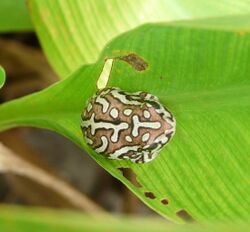Biology:Hyperolius parallelus
| Hyperolius parallelus | |
|---|---|

| |
| Scientific classification | |
| Domain: | Eukaryota |
| Kingdom: | Animalia |
| Phylum: | Chordata |
| Class: | Amphibia |
| Order: | Anura |
| Family: | Hyperoliidae |
| Genus: | Hyperolius |
| Species: | H. parallelus
|
| Binomial name | |
| Hyperolius parallelus Günther, 1858[2]
| |
| Synonyms[3] | |
| |
Hyperolius parallelus, also known as the Angolan reed frog (being treated as Hyperolius angolensis by many authors[3]), is a species of frog in the family Hyperoliidae. It is found in Southern and Central Africa.[1][3] It is part of the so-called Hyperolius viridiflavus species complex[1][3][4] and has a complex history of taxonomic treatments.[3][5]
Description
In samples from Central Africa, adult males measure 30–38 mm (1.2–1.5 in) in snout–vent length.[6] The tympanum is not visible. The head and snout are short. The syntypes were dorsally dark brown with three white, parallel bands;[2] nevertheless, the dorsal pattern is variable.[7]
Distribution and habitat
Hyperolius parallelus is found in southern Republic of the Congo and Democratic Republic of the Congo, Angola, northern Namibia and Botswana, and western Zambia;[1][3] the exact limits of its range are not clear and might extend into Gabon and Zimbabwe. It occurs in savanna, grassland and bush land, as well as many human-modified habitats such as cultivated land, towns, and gardens; it is associated in with emergent vegetation at the margins of swamps, rivers and lakes. Reproduction takes place in both temporary and permanent bodies of water and the eggs are laid directly into the water.[1]
Conservation
This widespread and extremely abundant species is not facing any significant threats; it readily colonizes newly created waterbodies. It probably is present in many protected areas.[1]
References
- ↑ 1.0 1.1 1.2 1.3 1.4 1.5 IUCN SSC Amphibian Specialist Group (2013). "Hyperolius parallelus". IUCN Red List of Threatened Species 2013: e.T56176A18379951. doi:10.2305/IUCN.UK.2013-2.RLTS.T56176A18379951.en. https://www.iucnredlist.org/species/56176/18379951. Retrieved 15 November 2021.
- ↑ 2.0 2.1 Günther, Albert C. L. G. (1858). "Neue Batrachier in der Sammlung des Britischen Museums". Archiv für Naturgeschichte 24: 319–328. doi:10.5962/bhl.part.5288. https://www.biodiversitylibrary.org/part/5288.
- ↑ 3.0 3.1 3.2 3.3 3.4 3.5 Frost, Darrel R. (2021). "Hyperolius parallelus Günther, 1858". Amphibian Species of the World: An Online Reference. Version 6.1. American Museum of Natural History. doi:10.5531/db.vz.0001. https://amphibiansoftheworld.amnh.org/Amphibia/Anura/Hyperoliidae/Hyperoliinae/Hyperolius/Hyperolius-parallelus.
- ↑ Channing, Allan; Rödel, Mark-Oliver (2019). Field Guide to the Frogs & other Amphibians of Africa. Cape Town: Struik Nature. pp. 396–397. ISBN 978-1-77584-512-6.
- ↑ Marques, M. P.; Ceríaco, L. M. P.; Blackburn, D. C.; Bauer, A. M. (2018). "Diversity and distribution of the amphibians and terrestrial reptiles of Angola. Atlas of historical and bibliographic records (1840–2017)". Proceedings of the California Academy of Sciences. 4th Series 65 (Suppl. II): 1–501. http://researcharchive.calacademy.org/research/izg/PCAS%20v65%20Suppl%20II%2028Dept18%20Angola%20(CAS%20web).pdf.
- ↑ Dehling, J. Maximilian; Sinsch, Ulrich (2019). "Partitioning of morphospace in larval and adult reed frogs (Anura: Hyperoliidae: Hyperolius) of the Central African Albertine Rift". Zoologischer Anzeiger 280: 65–77. doi:10.1016/j.jcz.2019.04.003.
- ↑ Conradie, W.; Branch, W. R.; Measey, G. J.; Tolley, K. A. (2012). "A new species of Hyperolius Rapp, 1842 (Anura: Hyperoliidae) from the Serra da Chela mountains, south-western Angola". Zootaxa 3269: 1–17.
Wikidata ☰ Q516797 entry
 |


